THOUGH THEY MET ONLY YESTERDAY, Micah Black and Dominique Perret are touching noses on top of Whistler Mountain, the world-famous snow-clogged ski resort nestled in southwestern British Columbia’s Coast Range. This is both unusual and normal. Unusual because Black and Perret, arguably the two best freeskiers in the world, don’t often go to the summits of alpine peaks to stand around snout to snout like golden retrievers. Normal because freeskiing remains a primarily visual phenomenon, and Black and Perret make a good living performing absurd acts for photographers, like the one popping his shutter at them right now, some ten feet away.
“Don’t try to kees me,” says Perret.
“Don’t kiss me, Tinkerbell,” Black neighs back.
We’ve come to Whistler Blackcomb Ski Resort in early May to stage Black vs. Perret—a competition that’s as close to a freeskiing heavyweight championship as you’re ever likely to get—and the photographer figures the nose-touching pose will evoke head-to-head combat, like in an old Hagler-Hearns boxing poster. Sure, Black and Perret are choking back laughter, but they’ll have their game faces on soon enough. Not only will the contest—conceived and made possible by this magazine and Whistler Blackcomb as a spicy alternative to the more regimented vibe of World Cup and Olympic racing—anoint an overall king of the mountain, but it will also help settle a longstanding debate.
Which is: Does the “total skier” come from the Alps, with its legacy of great alpinists making technical and precise turns down deadly faces? Or have the Americans, who co-opted “extreme skiing” and rechristened it “freeskiing” in the nineties to denote their showy high-speed, high-flying big-mountain style, earned the ultimate bragging rights?
During the next three days, it’ll be New World (in this corner, from Jackson Hole, Wyoming, the lanky, longhaired Black!) against Old (from Verbier, Switzerland, the clean-shaven, barrel-chested Perret!) in a joust to reveal the best all-around performer. The contenders will ski hard, certainly. But because freeskiing involves a broad array of skills, they’ll also be required to demonstrate their party-dude abilities (during an all-night barhopping tour of Whistler Village) and dirtbag affinities (by washing dishes at a Whistler restaurant). So it is that Perret, the Icon of the Alps, and Black, the Bro Brah of the Northern Rockies, have agreed to meet at Whistler, with its world-class terrain of glaciers, cliffs, and chutes, its frenzied late-night discos, and its platoons of overeducated lifties and steam-addled line cooks.
In this rarefied atmosphere, who will emerge as the ultimate badass? Gentlemen, click into your bindings.
The Players
Micah Black & Dominique Perret
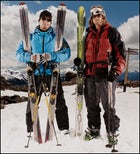 THE NEXT DAY: Perret (in blue) and Black arrive atop Whistler to begin the ultimate showdown.
THE NEXT DAY: Perret (in blue) and Black arrive atop Whistler to begin the ultimate showdown.THE YANK: MICAH BLACK
Black, 36, is an all-star jock by any measure. In 1995, he became the first American to snowboard the north face of Chamonix’s infamous 12,605-foot Aiguille du Midi. On skis, where he’s even more adept, Black has notched first descents in France, Alaska, Wyoming, Norway, Bulgaria, and New Zealand. In 2003, Powder readers named him one of the top three freeskiers in the world. A heartthrob and chat-room darling, he inspires swooning threads on sites like : “He has a dope name”; “Micah is drop-dead gorgeous”; “I mean, I’d let him jib my rail anytime.”
Now a bona fide “skilebrity,” Black has humble roots. He was born in Whitefish, Montana, and grew up in Spokane, Washington—an only child whose parents, Jim and Joyce, put him on skis at age two. In time, he distinguished himself from the pack by contorting his six-two frame into tricks and spins normally performed only by monkey-size jibbers. While ski-porn purveyors Warren Miller Entertainment and Matchstick Productions have filmed him, Black is best known as the carcass-hurling star of Teton Gravity Research, lighting up recent films like The Tangerine Dream and Soul Purpose. His talents earned him a gig starring in a 2000 commercial for the Nissan Xterra in which he threw a front flip over an SUV parked on a snowy mountain road.
Off the snow, Black rolls loose. He wears a tangle of dirty-blond hair, held back with a wide headband, à la Kid Rock. When he’s not making ski films (14 so far), he parties with Lars Ulrich from Metallica and Tommy Lee from Möey Crü In 2002, Cosmopolitan named him Wyoming’s representative in its Hottest Hunks in the U.S. issue, which got him an invite to Live with Regis and Kelly. Ski-movie headliners are often themselves called rock stars, but Black likes to point out that he’s actually cooler than that. “Real rock stars don’t scare themselves like we do,” he says. “They don’t live with the massive anxiety of a big-mountain descent.”
THE EURO: DOMINIQUE PERRET
In stark contrast, Perret, 43, is a clean-cut, thunder-thighed, six-foot native of La Chaux-de-Fonds, Switzerland, with a master’s degree in mechanical engineering, a very healthy ego, and starchy opinions about his freeskiing brethren.
“Freeriding shouldn’t be about a strange haircut or a bad attitude,” he says. Rather, it should be about strength and skill, both of which he has in abundance.
Perret’s high-altitude skiing is nearly peerless. In 1996, he attempted the first ski descent of Everest’s entire North Face. Climbing without oxygen, he made three summit attempts but was repeatedly turned back by minus-140 temperatures and 125-mile-per-hour winds. After 76 days in Tibet, many spent above 18,000 feet, he bailed—but not before skiing the North Face from 27,887 feet.
An athletically gifted youth from a ski-racing family—his father, Louis-Charles, was a Swiss Olympian—Perret grew up negotiating the trees and cliffs of La Chaux-de-Fonds, where he learned to ski very well and very, very fast. In 1991, he ripped down a speed-skiing track in Portillo, Chile, reaching 131 miles per hour (at the time, the seventh-fastest run on skis; the current record is 155). The year before, at Champéry, Switzerland, Perret nonchalantly threw a 120-foot cliff jump—a world record at the time—for kicks during a long downhill run. And in 1998, he set a world record for skiing endurance, sliding 353,600 vertical feet during 75 runs in just over 14 hours.
Well known throughout Europe from his tenure as a ski model, Perret has become an industry unto himself, grossing more than a million dollars a year. He’s published two books on “the Dominique Perret experience” and has produced and/or starred in 23 films. Natural Born Skier, Speed Is My Friend, Soul Pilot, and others have aired on TV in 100 countries and won 60 awards. And Perret’s fans love him: In 2000, European sports journalists and fans named him the 20th century’s best freeride skier.
Part 1: By the Rules
Dominique Perret
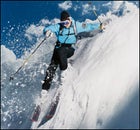 Perret pins his first run
Perret pins his first runOBJECTIVE:
To gauge the skiers’ technical prowess on a difficult course.
BLACK AND PERRET groan at the thought of going mano a mano in front of a scorekeeper; competitive freeskiing is normally the domain of lower-on-the-totem-pole athletes. These guys ski for cameras and cash, not judges. They make solo descents on rarely attempted peaks, and usually wait for clear weather. Sunshine improves visibility and makes segments pop onscreen.
Today the weather sucks—an overcast soup envelops Whistler Mountain’s Glacier Bowl, where they’re about to ski. No trees grow up here, so perspective is limited and vertigo is likely.
The duo duck under a rope with WARNING! CLIFF AREA signs, shoulder their skis, and trudge up the back of a ridge. They lock in and take their positions above unmarked runs that locals have named Exhilaration (which Perret will ski) and Excitation (Black’s route). The skiers gaze down at the dodgy conditions: old, unpredictable spring snow and sharp, protruding rocks. The runs are so steep that they can look between their ski tips, now jutting over the edge of the ridgetop, and see the respective bottoms.
Hundreds of feet below, Joe Lammers, a 35-year-old Whistler patroller who often judges IFSA contests, will grade them on five categories: line, aggression, fluidity, technique, and control. The skiers will make two runs each; the average score from both determines the winner.
Black goes first, whipsawing his boards perpendicular to the fall line for three turns. Then he releases his edges, lets his skis go with gravity, and sails over a rock band. He lands the air cleanly and rockets down the apron.
Perret waves a pole to announce his start. He makes two disciplined, braking turns as he approaches some sharp volcanic rocks—”cheese graters” in freeskier parlance—then he makes a halting, chicken-scratch move to line himself up safely for his mandatory ten-foot air.
Lammers deducts one fluidity point. Perret sticks his landing, though, and slashes the firm snow below with such force that the whoosh of his turns reverberates through Glacier Bowl. Lammers looks up from his score sheets. “Micah floats through microterrain features and seems to use his feet and ankles more,” he tells me, “while Dom just gets low and plows through anything and everything.” Lammers awards Black the first heat by a slim margin: 29.5 to 28.5.
The skiers choose similar lines for their second runs. Perret shows his remarkable consistency by putting up a mirror image of his first run. Black, who arrived at Whistler Blackcomb in a bolo tie and a Stetson, cowboys up for his second run down Excitation. He goes faster, takes 15 feet of air, and nails every move. Lammers gives him the highest possible marks for aggression, fluidity, technique, and control. Black wins this heat, too, 33 to 29, though Lammers is quick to point out that “both guys pinned it.”
Part 2: Keepin’ It Real
Micah Black & Dominique Perret
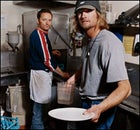 Meanwhile, Black rocks the suds
Meanwhile, Black rocks the sudsTHE CHALLENGE:
Wash dishes at Garibaldi Lift Company, a bustling slopeside bar/restaurant.
OBJECTIVE:
To regain an appreciation for the little people in the ski universe.
BLACK LOOKS AT HOME in front of the GLC’s industrial Hobart dishwasher. He should; he’s a bona fide ski bum, and he’s washed dishes “professionally” before, in Jackson Hole. He wears his apron snug and straight over a gray T-shirt, and he moves beer steins from busboy trays to the Hobart with nary a wasted motionas firm and no-nonsense as a mother cat moving kittens by the scruffs of their necks. As Black will proudly tell you, he never sought higher education. “Skiing is my college degree,” he beams. “That’s what I have. And I’ve made that into something.”
Perret, on the other hand, seems out of sorts as a sudsman. For one thing, he’s dressed all wrong, wearing a nice, suffocating sweater under his apron and a fancy Swiss watch from Hublot, yet another of his high-dollar sponsors. Perret wipes his hands too often, only to get them wet and slimy again moments later. He actually holds glasses up to the light to gauge their cleanliness, which is much too orderly and far too Swiss to fly in a chaotic Whistler kitchen.
One enduring urban legend of ski resorts is the dishwasher with the Ph.D. Though in reality there may be more bachelor’s and master’s degrees found around ski towns, it takes little prompting to get Black and Perret to philosophize about the reasons why so many people are willing to slave away for lift tickets and powder days. Between them, they have skied a cumulative 75 years, and they’re each on snow more than 80 days a year, but neither sounds the least bit jaded.
“Skis are like transmission lines,” Perret says. “They put energy into you. It physically comes in”
“That’s the addiction of it,” interjects Black. They are standing in the GLC’s kitchen, beneath a poster for Kokanee beer and another of Canadian downhiller Erik Guay. “My favorite sensation is coming over a rollover weightless. Weightlessness is a wonderful thing. Everybody should feel it. That’s all I need. Hide the liquor and let’s get mashed.”
“In the middle of the turn, it’s grace,” Perret replies. “It’s a gift. Skiing before that moment is hard, and it will be hard again later. But it’s a beautiful moment.”
When the final dishes are counted, Black wins this event, but give the Swiss swabbie a few extra points for eloquence!
Part 3: Throwing a Shoe
OBJECTIVE:
To see who has the most coordination and wherewithal in a compromised situation.
LOSING A SKI (“THROWING A SHOE”) symbolizes the varied disasters that befall out-of-bounds skiers. The unpredictable snowpack of the backcountry—especially breakable crust—routinely yanks skis off. Avalanches can strip a victim’s board, boot, sock, and even pants, so getting out alive can come down to one-ski maneuvering.
We, the unfilmed and unsponsored, biff immediately after throwing a ski. We lack the pro’s catlike agility and superhuman quadriceps strength. For a normal person, it’s a considerable challenge to ski on one plank down a groomed run, let alone through a steep black diamond with egg-carton bumps—like the run we’ve chosen for today, on the skier’s-left side of Whistler Bowl.
I expect Black and Perret will ski a fair length, and they do. As the bumps soften in the spring sun, Black wiggles downhill on a 185-centimeter B4 from Rossignol, his longtime ski sponsor. He stands tall and attempts to ward off wayward deflections with quick flicks of his poles. He’d normally bend his knee more, but it’s encased in the plastic brace he’s worn since he tore up his ACL in 1996 in an accident he suffered while guiding in Alaska. Black dances down the slope until an impudent hump tosses him on his caboose about 70 yards from the start.
Perret clips into a 201cm Stormrider DP, a ski that DP designed for the Swiss manufacturer Stöckli. Skiers testify that it’s the stiffest ski on the planet, but Perret has no trouble bending it to his whims. He sinks his 198 pounds into the ski and fires downhill. With his poles spread wide for balance, he absorbs shocks with his thick, coil-sprung leg. All told, Perret travels some 30 yards farther than Black before he topples sideways, the winner.
Part 4: Clubbing!
OBJECTIVE:
To determine who has real bonhomie and people skills.
SUSHI VILLAGE, arguably the toughest dinner reservation in town, is packed to its uncooked gills on this Saturday night. Over spider rolls and edamame, we discuss the rules of tonight’s contest: Since “going big” applies to partying as much as freeriding, the skiers will tour Whistler’s wildest clubs, drinking, dancing, and flirting with the ladies. (The flirting is for simulation purposes only: Black has a serious girlfriend, so he would be competing illegally, so to speak.) Whoever folds first loses.
The journey begins at Tommy Africa’s, a legendary Whistler hangout. Perret swooshes in wearing a silky red Chinese-flavored shirt from his lone American sponsor, Oakley. Black wears a Dickies workin’-man shirt with a logo from Spyder, his main clothing sponsor; a tie adorned with a skier doing a back-scratcher; and a poofy white pimp cap, given to him by a woman at a Mötley Crüe concert in exchange for a camouflage trucker hat and a T-shirt claiming I PARTIED ALL NIGHT WITH TOMMY LEE.
Perret cuts through a fog machine’s effluvium and onto the dance floor. Below an elevated go-go dancer, he boogies to Sir Mix-a-Lot’s “Baby Got Back,” displaying impressive rhythm for a Swiss engineer.
We roll on to Garfinkel’s, another jammed club with vibrating walls. Black enters with panache. “Here I am,” he announces to a Hindi girl who’s too hot not to have a portfolio or her own Web site. She ignores him, but few others do. Two guys in hoodies, clearly TGR fans, yell “That was Micah Black!” after he passes. Black chats up a beautiful Polish blonde, who gushes, “I’m drunk right now, but you inspire me because you love what you do, and I want to ski because of you.”
The night rolls on. And on. The skiers’ endurance is most impressive. Girls come and go, including Colleen, an ex-girlfriend of Black’s who lives in Whistler. But it’s Perret who wins her over with some whispered French. Nevertheless, after a while Colleen leaves alone.
Whistler—a no-holds-barred tourist magnet that’s as close as British Columbia ever comes to Vegas—energizes both Black and Perret. And it bonds them, too. The two skiers end up watching the sunrise from the same place, a hot tub on a balcony of the Sundial Boutique Hotel. Though they’ve both pulled the all-nighter, Perret gets the edge thanks to his Swiss charm and lack of inhibition on the dance floor.
Tie game!
Part 5: Straightlining
Micah Black
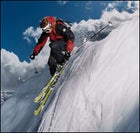 Back at Whistler, Black attacks the hill
Back at Whistler, Black attacks the hillMicah Black
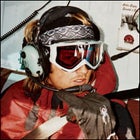 With help from the chopper
With help from the chopperOBJECTIVE:
To further separate our heroes from park monkeys and in-bounds aces.
STRAIGHTLINING—A.K.A. “pointing ’em”—means going straight down a steep pitch for a long stretch at an extremely high speed. It’s one of the more demanding parts of cinematic freeskiing, and it’s also the “technique” freeskiers use to outrun sloughs and slides.
We wait a good part of the day for flyable weather. It’s well after lunchtime when we head to the hangar of our heli-skiing guides, Blackcomb Helicopters. On the drive over, Black and Perrett drift again into philosophic repartee, wrongly assuming we’re still awarding points for that.
“To turn is to admit defeat,” Perret grins. “Going straight on long skis is like sixth gear in a sports car, going faster but with lower RPMs. I like putting it into the sixth. If you want to be passionate, let it be from the hairs to the toes.”
“I totally agree with your theory of the ski,” Black says, echoing Perret’s Swiss-English diction. “I, too, wish to put it into the sixth. Too often American ski movies are about taking jibbers into the backcountry. All they want to do is build a cheese-wedge kicker and pull grabs. They’re one-trick ponies.”
Not these horses. Everything about them radiates bigness: Black’s height, Perret’s fireplug build. Even their sunglasses are oversize. Perret cloaks most of his skull in Oakley Monster Dogs. Black does the same in Smith Bajas.
Their lines, naturally, are huge.
We fly to the Spearhead Glacier in the late afternoon’s golden glow. A test run reveals that the soft-looking snowpack is, in many places, hard cauliflower—the type of snow that sends advanced skiers on prolonged, rag-dolling cartwheels but that pros like Perret and Black easily eviscerate. They get out of the helicopter atop an 1,800-foot face and buckle their boots.
Black, who in the mid-nineties guided “engineers from Illinois and strippers from New York” on ski trips in Alaska, drops in on a Chugach-like spine. His turns are artful, a perfectly balanced, nuanced descent from flank to flank of the snowbound dihedral. He exhibits his mastery of what freeskiers call “spineology.”
Perret plunges down the less fluted face, carving bigger, longer, more powerful turns. Both of their runs reduce the peaks to whimpering mounds of rock. But neither pulls a long, straight line on the first go.
During his second run, however, Black nails down his victory in this event. From high on the face he points ’em straight and rockets fast and fluid all the way to the glacier’s basin. “I love ripping fast,” Black says. “I love the freedom.”
Perret’s second attempt is also inconceivably strong and speedy, but he makes ten more turns than Black. Granted, they’re huge, thigh-melting turns at Mach 5 that only .0001 percent of skiers could make. The speed—50 to 60 miles per hour down a steep mountainside—causes him no discernible fear.
“The most scared I’ve ever been was in Mexico City during earthquakes,” Perret says later. “There was no control. In the mountains, you always have a choice.”
Final Score
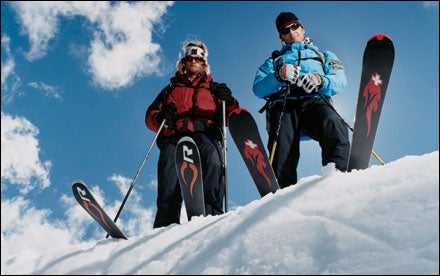
BLACK WON THREE challenges (steep skiing, dishwashing, and straight-lining) to Perret’s two (throwing a shoe and partying). So, technically, Black is our winner.
But let’s pause a moment before declaring him Absolutely, Without Peer, the Finest Freeskier in the Solar System. Perret, after all, has withstood vicious jet lag and the brain-frying stress of speaking in a foreign language for six days.
Also, during another photo shoot atop Whistler Mountain, he pulled the competition’s best trick. We were milling about aimlessly when Perret opened his backpack and produced a bottle of wine. He then removed several wineglasses and announced that the vino was a Viognier pressed from grapes grown in his own backyard. He’d skied off cornices all day with fragile glass in his pack. Had the contest taken place in Chamonix or Verbier instead of electrolyte-swilling North America, the move might have secured Perret victory right there. In Europe, freeskiing honors the whole ski lifestyle and its ancient sophisticated attributes. On this side of the Atlantic, freeskiing is more a rebellion against the tight-ass conventions of the sport; it’s more likely to flash tattoos than corkscrews.
As Black happily tippled Perret’s wine, it was clear the week had become less a clash of the titans than a chance for some intercontinental bro-brah bonding. Whatever testosterone-fueled competitiveness they harbored, it was crowded out by their shared passion for their sport and a united effort to combat their true common enemy: summer.


